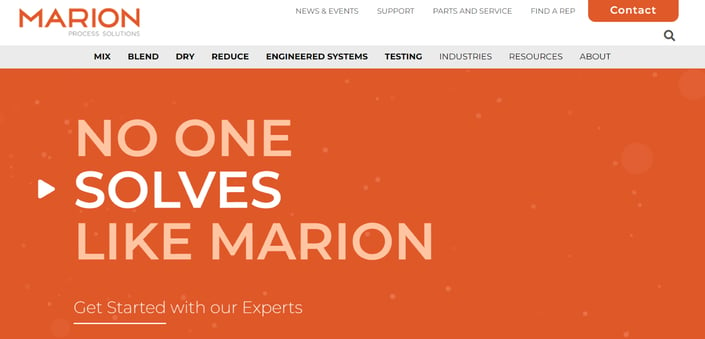How UX Drives B2B Marketing Success

What Website User Experience Works Best When Marketing to Engineers
"Design is a funny word. Some people think design means how it looks. But of course, if you dig deeper, it's really how it works.” -- Steve Jobs
It being impossible to talk about design without at least one reference to Steve Jobs, we thought we’d get it out of the way.
UX, or website user experience, is one of the hot B2B marketing buzzwords of the moment. But what does UX mean, and how can you best implement UX if you are selling to engineers?
To answer these questions, I sat down with Erin Klees, Goldstein Group’s Director of Brand Impact and a true UX expert, to gain her insight.
According to Klees, many will say that UX is a beautiful design with pretty graphics, a great color palette, and eye-catching visuals. But she says it’s critical to think about how visitors interact with your website design… how they find information on your products and develop trust that will ultimately result in a sale and a relationship.
She says engineers seek information online to make critical technical decisions. Because of time-to-market and downtime pressures, they need to find that information quickly. Most importantly, they need to be confident that their suppliers are trustworthy experts who will help them arrive at the best solution for their application. Your website should inspire confidence and make information easy to find.
Know Who You’re Designing for (and It’s Not You)
Effective user experience web design should promote a desired behavior. Question number one should be, “who are we trying to elicit a behavior from?” Who is the engineering audience for our design? Potential customers? Existing customers? People with a good understanding of an application but not with our solution, or people new to both? What are the desired engineering personas, and how do they currently interact with our site?
There’s a lot of groundwork in that last paragraph. Klees points out the trap of relying on anecdotal evidence. Sales says this, one customer mentions that, and so on. Fortunately, there are tools that track web traffic, show where customers are interacting (and not interacting), where they get lost, where they drop off, and where they go next. Tools like Google, SEMrush, Clarity, and HotJar will point the way.
A good early exercise is to find the pages on your site that have high traffic but low engagement. Consider why. Could it be a technical issue such as a slow-loading site or a poor mobile rendering? Or is the promise of the page (what garnered the click) not living up to expectations? What content could be added to the page to keep visitors engaged? Where is content placed on the page, and is the page layout effective?
Klees says this is where a heat mapping tool becomes crucial. Are you getting “rage clicks” such as clicks on a headline or static images that a user thought should lead somewhere? These can be clues that you’re not structuring the content the way users want to interact with it. Maybe an infographic could succeed where a white paper fails, or a video may work better than a blog. Maybe your page traffic drops off significantly “below the fold.” This could mean your design needs to be visually updated to encourage a deeper dive.
Use customer interviews and the abundant tools available to track both traffic and engagement. Once you see the pinch points, you will gain insight into the behaviors that your current site elicits – or doesn’t!
Know What You Want the Website to Accomplish
What is the desired behavior you want to produce? Klees says at this stage of UX, it’s imperative to involve Sales. How do they develop a lead into a sale? Are there common questions they answer over and over? And what are the most common ways they win a sale?
By knowing the current sales process, marketers can find the ideal spots to hand over a marketing lead to Sales for contact. UX is about finding the Goldilocks spots where enough content and information have been shared and a personal contact can push that contact over the finish line to a closed sale.
The web content should engage and inform, removing steps from the sale process. Answering common customer questions is a great place to start. Whatever your web content, it should be tailored to your target customer persona. Map out what content to offer, where to offer it, and in what format. Most B2B marketers target multiple personas. Klees says the website needs to provide paths to content for each type of visitor. Also, she says marketers must measure the performance of content on the site. By understanding which content influences sales, web designers can bring forward the most effective content.
7 UX Design Tips for B2B Websites
After you’ve done the research and defined your desired behavior, you can start to design the website. This is where your research, insights, and talent combine to result in a true impact on your site. Klees offers these design tips.
Be a Hero (shot) – Make your home page a visual statement of your company’s brand. Show a broad list of products, services, and capabilities with clear calls to action, so a visitor can find a point they identify with and then be driven deeper into the site.
Optimize – Make sure every page has a clear hierarchy of messaging, with content displayed in engaging ways to increase visibility and engagement. The page’s main message should on top, followed by brief bullet points or text that asks a question.
Visual Cues – Use your design elements to re-enforce the hierarchy of your messaging. Use bold colors to set off CTAs. Include images that show the end result or application, not just still product pictures. Offer videos, icons, and infographics that increase engagement.
Short Bites – Now, take all that information and break it into small visual sections. Visitors should be able to scan the web page, get a quick understanding, and decide to either click for more information or skim to the next section.
Break Down and Cross Over – By utilizing a sort function, visitors can filter blogs and resources by industry, application, and product, so they can easily find the content they seek. Then use those topic sorts to identify content that you can post on relevant pages.
Be Consistent – When designing, make sure your page works on multiple devices in a consistent manner. The brand you’re establishing needs to look the same everywhere to be effective.
Funnel Information – Maybe the only marketing term bandied about more than “UX’ is “sales funnel,” but both can help each other. If you treat the website user experience as the journey through the sales funnel, then you can tailor the content to each stage of the buyer’s journey:
◦ Your home page gives general information on your visitors’ applications and your solutions.
◦ The top-level pages build upon your value proposition, trading visuals and general
information for details on how your company’s solutions solve the visitors’ problems.
◦ Deeper into the site, offer enticing gated content that addresses customer pain points.
This site we built for Marion Solutions is an excellent example of how all this can come together. Previously, Marion’s website placed its custom-built products front and center. Unfortunately, they were potentially losing customers who didn’t see a product that fit their exact needs.
Using the UX guidelines outlined here, Goldstein Group restructured the website, focusing the home page on the visitor’s manufacturing process rather than on Marion’s product catalog. From there, the visitor drills down into the process categories that are relevant to them. Farther into the site, the agency positioned custom products as proof of the company’s expertise.
UX Is Critical to B2B Websites
User experience needs to be a part of every B2B marketing strategy. Do your homework, create relevant content, and design web pages smartly. UX will become an essential partner in your sales efforts by developing knowledgeable customers who trust in your company’s ability to help them.
If you are wondering if your company website could benefit from a UX audit, get a professional opinion. Please send us a note using our Contact Us form.







